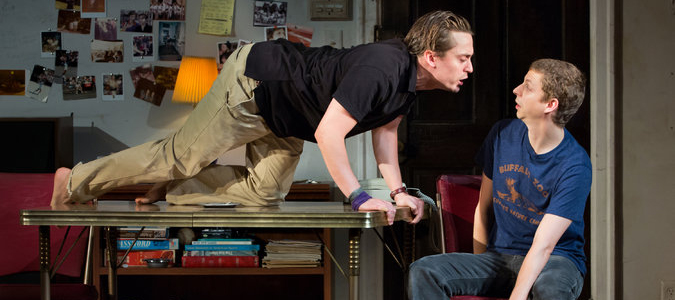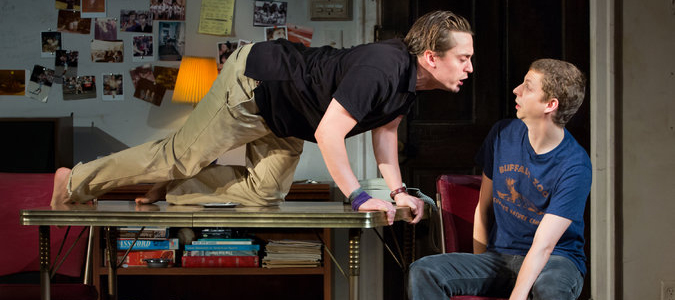

This Is Our Youth
Opening Night: September 11, 2014
Closing: January 4, 2015
Theater: Cort Theatre
Set in New York in 1982, This is Our Youth follows forty-eight hours in the lives of three very lost young souls: Warren (Michael Cera), a dejected nineteen year old who has just stolen $15,000 from his abusive, tycoon father; Dennis (Kieran Culkin), his charismatic drug-dealing friend who helps Warren put the stolen money to good use; and Jessica (Tavi Gevinson), the anxiously insightful young woman who Warren yearns for. Funny, painful and compassionate, This is Our Youth is a living snapshot of the moment when many young people go out into the world on their own, armed only with the ideas and techniques they developed as teenagers – far more sophisticated than their parents realize, and far less effectual than they themselves can possibly imagine.
BUY TICKETSREAD THE REVIEWS:
September 11, 2014
Just watch these bodies in motion: loping, flying, dancing, vamping and writhing at an altitude known only to the permanently high and perpetually crashing. The acrobatics being performed in Anna D. Shapiro’s sensational, kinetically charged revival of Kenneth Lonergan’s This Is Our Youth, which opened on Thursday night in a marijuana haze at the Cort Theater, aren’t anything like those you’d find at the Cirque du Soleil. But they’re every bit as compelling, and probably (painfully) a whole lot closer to your own experience. As brought to thin-skinned, full-blooded life by Michael Cera, Kieran Culkin and Tavi Gevinson, the three privileged and desperate young characters in Mr. Lonergan’s 1996 play exist in a state of unending free fall. And a studio apartment on the Upper West Side of Manhattan — designed by Todd Rosenthal with an awareness of the big city beyond — starts to seem as vast and scary as outer space. You may remember that this is what it feels like to be on the cusp of adulthood with a whole wide world waiting to eat you up. Though first performed nearly two decades ago, and set in the early 1980s, This Is Our Youth hasn’t dated in the usual way of portraits of bright and sullen young things banging their heads against the walls of a society that doesn’t understand them. That’s because for all its period-specific references, Mr. Lonergan never relies merely on surface details to define his characters’ uncomfortable place in time.
READ THE REVIEWSeptember 11, 2014
Funny how yesterday’s manboy becomes today’s sad old guy. But that’s always been Michael Cera’s trick, hasn’t it? Ever since he grew a cult fan base as frozen-in-the-headlights teen George Michael Bluth on Arrested Development, then starred in a series of instant-classic indie comedies (Juno, Superbad), Cera has managed to appear both fetally unguarded and crushed by the weight of the world (a millennial Charlie Brown). That broken-naïf vibe makes him perfect for Warren Straub in Kenneth Lonergan’s This Is Our Youth, in which Cera plays a jumpy and immature 19-year-old who already seems soured by the seedy banalities of 1982 New York. Warren’s so-called friend Dennis (Culkin) is two years ahead of him in that post-Me Generation, early-Reagan realm, which has already turned him into a vicious, manipulative prick. Bullying Dennis is a low-level pot dealer whose shabby Upper West Side apartment is paid for by parents who’d rather foot his rent than have him around. One night, Warren drops by lugging a suitcase full of collectible toys and a knapsack stuffed with $15,000 he stole from his lingerie-dealer dad. And thus a profane, heartbreaking coming-of-age plot is set in motion—Catcher in the Rye for stoners and slackers.
READ THE REVIEWSeptember 11, 2014
Chekhov meets Gossip Girl in This Is Our Youth, Kenneth Lonergen’s bruising but sensitive comedic drama about insecure and unsure teens living on the Upper West Side in the early 1980s. Since its 1996 Off-Broadway premiere, it has been acclaimed for its frank, casual depiction of affluent youths trying to rebel against their parents, while still attached to their purse strings, and getting carelessly mixed up in drugs and sex. Well-known actors that have appeared in various productions over the years include Mark Ruffalo, Matt Damon and Jake Gyllenhaal. Staged by Anna D. Shapiro (August: Osage County, Of Mice and Men) with raw intensity and a rough edge, the current Broadway production features Michael Cera, Kieran Culkin and writer Tavi Gevinson. Cera plays the awkward and anxious Warren, who shows up unannounced at his self-centered friend Donald’s apartment, having just stolen a wad of cash from his father.
READ THE REVIEWSeptember 11, 2014
A truly well-oiled — should we say well-rolled? — revival of Kenneth Lonergan’s This Is Our Youth opened Thursday on Broadway at the Cort Theatre with a super cast of rising-star millennials playing Gen-Xers. Michael Cera, making his New York stage debut, once again perfectly captures being an awkward man-boy, while veteran fashionista and acting newbie Tavi Gevinson matches his goofy nervous energy. Kieran Culkin is marvelous as their smug, narcissistic friend. Spending two hours watching these wealthy, unmoored slackers is a treat, even without the contact high. The production, which premiered at the Steppenwolf Theatre Company in Chicago this past summer, is directed by Anna D. Shapiro, who knows her way around onstage arguments (August: Osage County) and movie stars (James Franco in Of Mice and Men). She keeps this revival fresh and electric, crackling with energy even as the stoned get more stoned. Set in 1982 at the beginning of the Reagan Era, the entire play takes place over two days at the Upper West Side apartment of Dennis (Culkin), a small-time drug dealer with wealthy parents. He gets an unexpected visit from his weird friend Warren (Cera), who fled home after having a disagreement with his dad and taking $15,000 (“the proceeds from my unhappy childhood”).
READ THE REVIEWSeptember 11, 2014
It’s been nearly two decades since Kenneth Lonergan’s This Is Our Youth first appeared with its searing portrait of college-age entitlement and ennui. The drama, which helped launch the career of Mark Ruffalo as well as Lonergan, is now back in a crackling Broadway revival by director Anna D. Shapiro that runs through Jan. 4 following a successful run this summer at Chicago’s Steppenwolf Theatre. In their Broadway debuts, Kieran Culkin and Michael Cera establish an appropriately uneasy rapport as two Manhattan trustifarian stoners, the progeny of a famous painter and a lingerie tycoon who seem to want very little to do with their college-dropout sons. Culkin’s Dennis is a bike messenger and sometime dope dealer with a serious alpha-dog streak, while Cera’s Warren is a depressive ne’er-do-well and perpetual hanger-on who gets kicked out of his dad’s place and turns up at Dennis’ Upper West Side studio apartment with a giant suitcase and $15,000 of his dad’s cash.
READ THE REVIEW




















